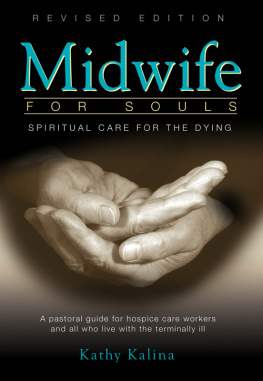Midwife for Souls
Spiritual Care for the Dying
A pastoral guide for hospice care workers and all who live with the terminally ill
REVISED EDITION
by Kathy Kalina

Nihil Obstat: Reverend Timothy Shea, S.T.L.
Imprimatur: Sen Cardinal OMalley, O.F.M. Cap.
Archbishop of Boston
October 23, 2006
Library of Congress Cataloging-in-Publication Data
Kalina, Kathy.
Midwife for souls: spiritual care for the dying / by Kathy Kalina.
Rev. ed.
p. cm.
Originally published: St. Paul Books & Media, 1993.
Includes bibliographical references.
ISBN-10 Print: 0-8198-4856-5
ISBN-10 eBook: 0-8198-4873-5
ISBN-13 eBook: 978-0-8198-4873-4
1. CaregiversReligious life. 2. Hospice careReligious aspectsChristianity. 3. Terminal careReligious aspectsChristianity. I. Title.
BV4910.9.K35 2007
259.4175dc22
2006033299
The Scripture quotations contained herein are from the New Revised Standard Version Bible: Catholic Edition, copyright 1989, 1993, Division of Christian Education of the National Council of the Churches of Christ in the United States of America. Used by permission. All rights reserved.
English translation of The Apostles Creed 1988 English Language Liturgical Consultation (ELLC). 1988, and used by permission. See www.englishtexts.org.
Cover design by Rosana Usselmann
Cover photo by Mary Emmanual Alves, FSP
All rights reserved. No part of this book may be reproduced or transmitted in any form or by any means, electronic or mechanical, including photocopying, recording, or by any information storage and retrieval system without permission in writing from the publisher.
P and PAULINE are registered trademarks of the Daughters of St. Paul.
Copyright 1993, 2007, Kathy Kalina
Published by Pauline Books & Media, 50 Saint Pauls Avenue, Boston, MA 02130-3491. www.pauline.org.
Pauline Books & Media is the publishing house of the Daughters of St. Paul, an international congregation of women religious serving the Church with the communications media.
For Mary,
the ultimate Jewish mother.
Let us love
with the urgency of the dying
and the innocence of the newborn.
Let us love
with the abandon of adolescence
and the certainty of adulthood.
Let us love
generously and openly
taking all risks
for as we have been loved,
we must love in return.
And in the love that redeems us,
we open our hands and hearts
gathering a bouquet
to offer to heaven.
Katherine Mary Krsak
Contents
MIDWIFE FOR SOULS IS A BOOK on hospice care, but it is much more than that. It is a how to for family members, friends, and hospice professionals involved in caring for terminally ill patients as they enter into the phase of their last moments, when life slowly ebbs away and death releases the soul to go home to God. These last days or hours are very difficult for family members, who often watch helplessly by the loved ones bed, not knowing what to do or say.
The author is a nurse, but she is also a deeply spiritual person writing from her personal experience. Kathy Kalina makes no apologies for being one hundred percent Catholic, but her deep understanding of what human beings go through as their lives come to an end makes the book useful to everyone regardless of religious preference. It is written in a style that is both poetic and beautiful as well as practical and credible. It talks about how powerful prayer can be; it talks about how important it is for hospice caregivers to be attuned to this God if they are to be effective midwives for souls.
I highly recommend this book for all who care for the dying whether as professionals, friends, or family members. The many stories of peace and joy coming into peoples lives, even in the last few moments before death, point to why euthanasia must never be an alternative for anyone. Hospice care relieves pain and sufferingphysical, psychological, social, and spiritualso that patients can face the end of their lives in peace and with dignity. Just as midwives help mothers deliver a child, so hospice caregivers help the soul as it is born into eternal life. It is a sacred mission; it is a true vocation. I rejoice that a book on the Spiritual Care of the Dying has finally been written.
Josefina B. Magno, M.D.
President, International Hospice Institute
I HAVE COME TO BELIEVE THAT there are no accidents. My dear friend Dodie urged me to become a hospice nurse, and I assisted at her death in that capacity six months later. Ill never forget sitting beside her bed as she told me that she had no intention of dying, thank you very much. Inspired by the grace that abounds at such times, I told her, I am here as the midwife of your soul.
I dont think Ive ever prayed harder in my life, and I dont think Ive ever felt such spiritual strength. Twelve hours later, with an expression that radiated wonder and peace, Dodie was born to eternal life. What could have been an unbearable loss became a joyous homecoming, and Dodies parents were able to say that their thirty-four-year-old daughter had a beautiful death.
I went to Dodies house with head knowledge, but I left with heart knowledge. Dodies death transformed me into an apprentice midwife. I am still an apprentice. Patients and families are my teachers, and I will not graduate from this school until my own death. So I will share what I know as one apprentice to another.
Even though Im writing this book primarily for nurses, especially when beginning this work, I hope that those who want to serve as midwife for loved ones will also find it helpful.
Special Thanks
To the countless hospice workers who shared their stories with me;
To the patients and families who allowed me to be a part of their stories;
And to my parents, for showing me what a family can be.
One
I FELT CALLED TO HOSPICE WORK quite some time before I stopped whispering, Wrong number! Because of my hospital nursing experience, the thought of death conjured images of a slow, agonizing process, involving a helpless patient and a hopeless staff. It involved inflicting pain on already pain-racked bodies. Im still haunted by memories of tying patients down to keep them from pulling out tubes, repeatedly sticking IVs into worn-out arms, and assisting with heroic resuscitative measures that we called the million dollar send-off.
When I provided this type of care for the dying, I had the same sick feeling as when I participated in the hospital care of women in childbirth. Even though I knew the academic and legal rationales for distasteful practices, it never felt right.
Many times families would tell me, We want everything done for our mother. I would shake my head, thinking, They just dont know what everything is. Doctors have a tendency to think of death as a personal enemy, and thats usually good. If I have an illness that can be cured, I want my doctor to wage all-out war against it. But once it becomes evident that treatment is not going to be successful, I want to spend my last days in comfort and peace.
I can understand why its hard for doctors to turn about-face at this point, but it hurts my heart to see patients put through the rigors of treatment, even such drastic measures as artificial ventilation, because the doctors hate to fail. My friend Dodie, for instance, was encouraged to start another round of chemotherapy three days before she died.
Fortunately, more and more doctors are referring their patients to hospice care when a cure is unattainable. And more and more families are asking for, even demanding, hospice care when that point is reached.
Next page













